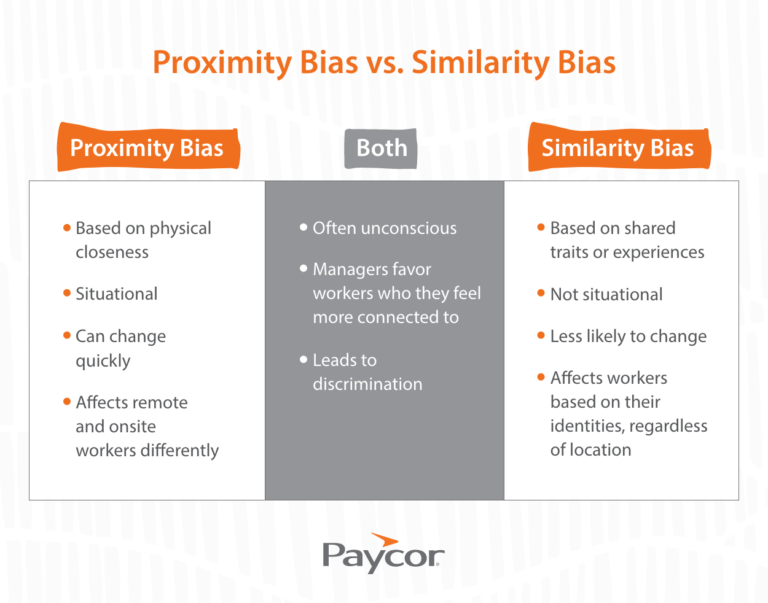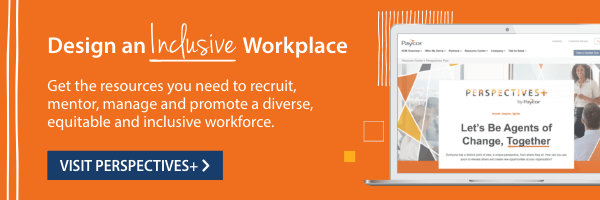In 2024, 14% of adults in the U.S. workforce work from home all the time (USA Today). By 2025, experts predict that number will go up to 20%. The rise of remote work is having a major impact on professional relationships. There are plenty of upsides to this, but it’s not black-and-white. In fact, a new form of favoritism is becoming more prevalent in the workplace: proximity bias.
What is Proximity Bias?
Proximity bias is the tendency of business leaders to favor people who are physically closer to them. For example, an executive based in New York might give plum assignments to an employee they see in the Manhattan office every day, instead of considering a high performer who lives in Los Angeles.
Unlike more overt forms of bias – like racism or sexism – proximity bias can be extremely hard to identify. It’s often unconscious, and it’s circumstantial. An employee can’t change their ethnicity, but they could move to a new city or switch to an in-office schedule at any time. Proximity bias may not be as visible or well-understood as other forms of discrimination, but its impact can be just as detrimental.
This form of bias relates to the misperception that remote workers are less productive. The “seeing is believing” mentality can lead to an “out of sight, out of mind” approach to managing remote or hybrid teams. That leads to a massive and damaging disconnect between the work being done and the way managers perceive it. According to the Harvard Business Review, “remote workers get promoted less often than their peers, despite being 15% more productive on average.”
As organizations continue to embrace flexible work arrangements, the potential for proximity bias has grown significantly. Below are some examples of how it can manifest in the workplace, and strategies for mitigating its effects to create a more equitable and inclusive work environment for all employees, regardless of their physical location.
Examples of Proximity Bias
Because this is a new concept for many, it can be hard to recognize proximity bias in action. Here are some situations to look out for in the workplace:
- Exclusive networking opportunities: Employees in the same city as the company headquarters get invited to weekly happy hours with executives.
- Unequal assignment of high-profile projects: Local workers are more likely to get assigned exciting projects because they’re top-of-mind for business leaders.
- Spontaneous recognition: In-person employees get more frequent and spontaneous praise from managers who see their work firsthand.
- In-person team-building activities: If all team-building activities take place in person, remote workers are isolated from company culture.
- Promotion disparities: Onsite workers get promoted more often than remote or hybrid team members.
Proximity Bias vs. Similarity Bias
It’s easy to confuse proximity bias with similarity bias, but they have some important differences. Similarity bias – also called affinity bias – is the tendency to favor people who share your characteristics or experiences. Both biases can lead to favoritism and even discrimination, but they have slightly different causes. To address either one, HR should know how to distinguish between them.

When you can recognize the difference between proximity bias vs. similarity bias, you can address the issue at hand. As remote and hybrid work get more popular, HR should develop strategies to combat these forms of bias.
How to Mitigate Proximity Bias
The best way to address proximity bias is a little different for every organization. Use these ideas to get started, and tailor them to suit your company’s needs.
Evaluate the Data
Start by collecting data on key metrics that could be impacted by proximity bias. You could look at promotion rates, project assignments, and participation in social events across local and remote teams. Analyze your findings to identify potential disparities.
Appoint Local Culture Champions
If you have workers in different areas of the country, designate local culture champions to organize group events. They could secure a co-working space, plan an outing to a baseball game, or just host a monthly team dinner. These in-person activities help build community and foster a sense of belonging.
Create Connections
Schedule virtual team-building events. These could be lectures by experts or inspirational speakers, book clubs, coffee chats, happy hours, or anything that aligns with your company culture. Give employees the chance to connect with each other, both one-on-one and in small groups.
Provide Leadership Training
Educate your managers and executives about proximity bias. In these training sessions, give them practical strategies to counteract it. Encourage them to hold each other accountable for supporting both local and distant team members.
Establish Clear Performance Metrics
Develop objective, specific criteria to measure employee performance. These metrics should apply equally to all employees, regardless of their location. Transparency is key here. When your entire team knows what’s expected of them, they can work toward shared and individual goals more easily.
How Paycor Helps
As a virtual-first organization, we understand firsthand how proximity affects working relationships. HR tools like Talent Development can improve communication across any distance. Our performance review tools foster a culture of feedback, helping managers connect with employees. Other features, like the recognition tool, help geographically distant team members build relationships with each other. Employees can publicly recognize one another for achievements, automatically notifying leaders of each other’s best work.
In addition to our suite of HCM software, Paycor’s resources can support HR leaders as they develop processes to interrupt bias.










